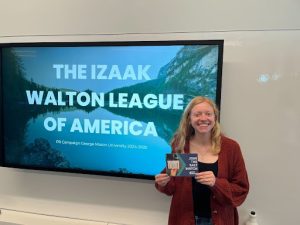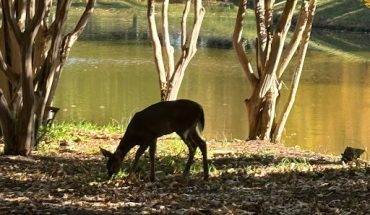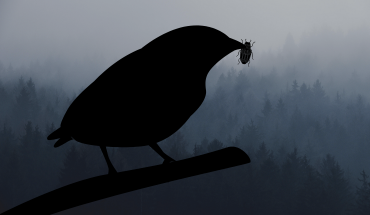Mason alum Margaretta Dombroski and her fight against water pollution
BY VALENTINA FALA, STAFF WRITER
Margaretta Walker Dombroski, a 2022 Mason alumna, is the Mid-Atlantic Save Our Streams Coordinator at the Izaak Walton League of America. In her role, she collaborates with local communities to combat water pollution. Volunteers monitor stream restoration projects, provide free water monitoring data to their counties, identify problems in their water streams and request immediate action. These efforts empower volunteers to test any body of water from a pond, stream, lake, puddle or even their own tap water.
Dombroski has always been fascinated by biology and later pursued a minor in environment conservation. During her time at Mason, she spent a semester at the Smithsonian-Mason School of Conservation’s Conservation, Biodiversity, and Society Program, studied wildlife conservation abroad in Kenya and contributed to urban forestry projects in Fairfax County. “Water pollution is something that affects everybody. A lot of the younger generations are really interested in environmental issues and want to take action, so working with the Mason students is a really good opportunity to try to learn,” Dombroski said.
Dombroski mainly coordinates the Virginia Save Our Streams program, where volunteers collect macroinvertebrates from streams to assess pollution levels. This data is sent to the Virginia Department of Environmental Quality. Participation in the program is free and requires certification through online webinars, an exam and a field day with a local field trainer. “A lot of our pollution now is non-point pollution, which is coming from all over the watershed,” Dombroski said. “Anything that goes into people’s lawns– like fertilizers, salts on roads and sidewalks, microplastics, pesticides–ends up in our waterways and a lot of these are odorless, tasteless, colorless, and invisible to us.”
Another popular initiative is the Nitrate Watch, which provides free kits to volunteers without requiring training or certification. Results from these kits are included in an online database. Nitrate, a pollutant commonly found in fertilizers and animal waste, can lead to nutrient overloading in water. This overloading causes algae blooms that affect aquatic life. Nitrate can also interfere with the body’s ability to transport oxygen, causing blue baby syndrome and increasing cancer risks. “Both salt and nitrate are really hard, if not impossible, to get out of drinking water. Most drinking water facilities do not filter those out. That’s why it is important to keep track of them,” Dombroski said.
The Salt Watch program follows a similar process and focuses on chloride pollution from causants like excessive road salt in the winter. Road salt can corrode infrastructures, pipes and cause heavy metals like lead to get into drinkable water and surpass regular water filters. “Obviously road salt is really important–we need it because it helps us stay safe in the winter. But we’re advocating for smarter salting practices and less salt since often much more than is necessary gets applied,” Dombroski said.
The Izaak Walton League of America, the oldest conservation organization in the United States, was founded in 1922. On Nov. 20, they will host a kiosk event in the Johnson Center (JC) from 1:30 to 4:30 p.m. Students will have the opportunity to meet Dombroski, use water-testing kits and learn more about their special programs. “Our mission is to defend the soil, air, woods, water and wildlife of the U.S. to allow people to enjoy them for years to come,” Dombroski said.
To learn more about how to get involved or to join water monitoring programs, visit the Izaak Walton League of America’s website.




